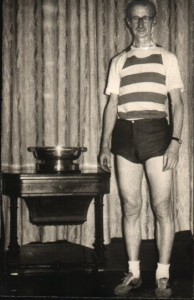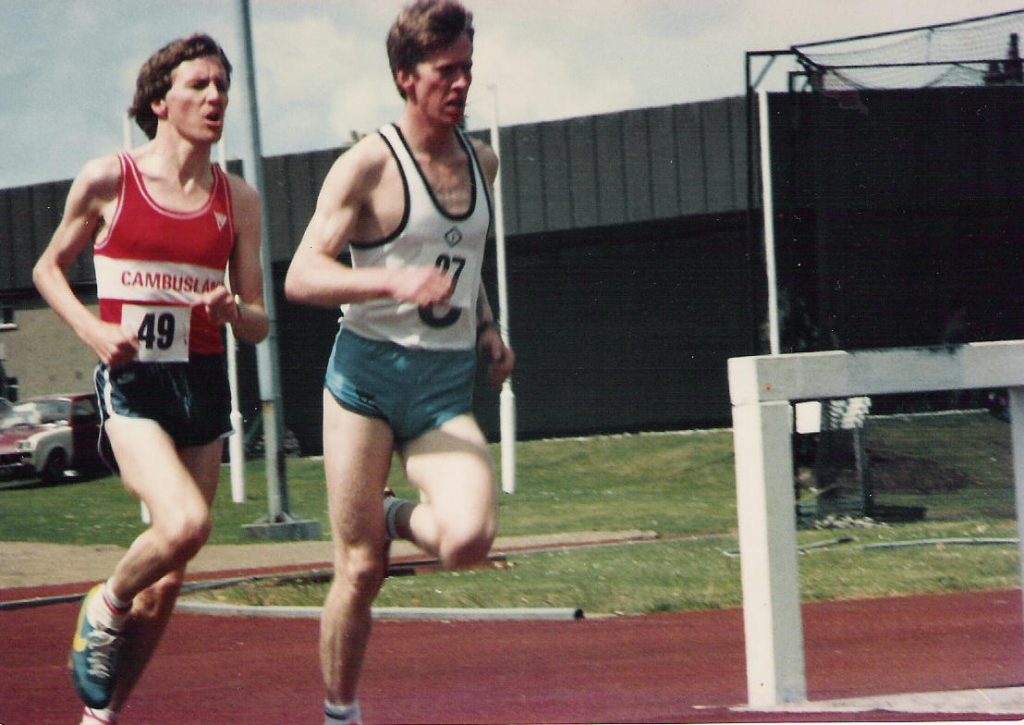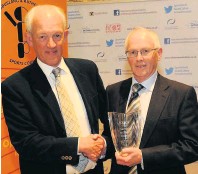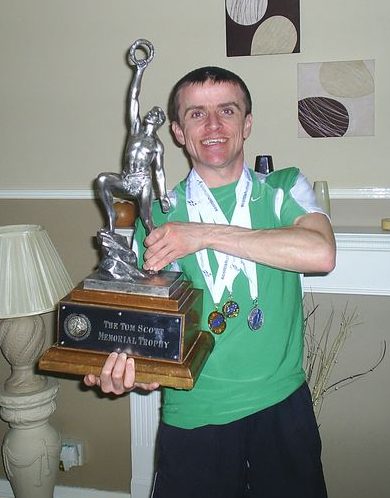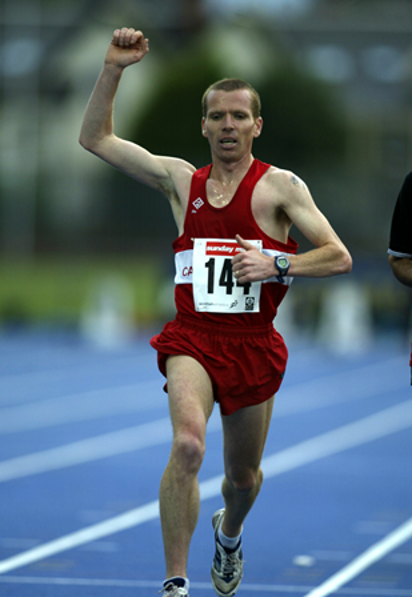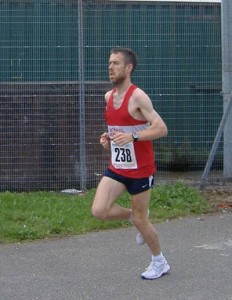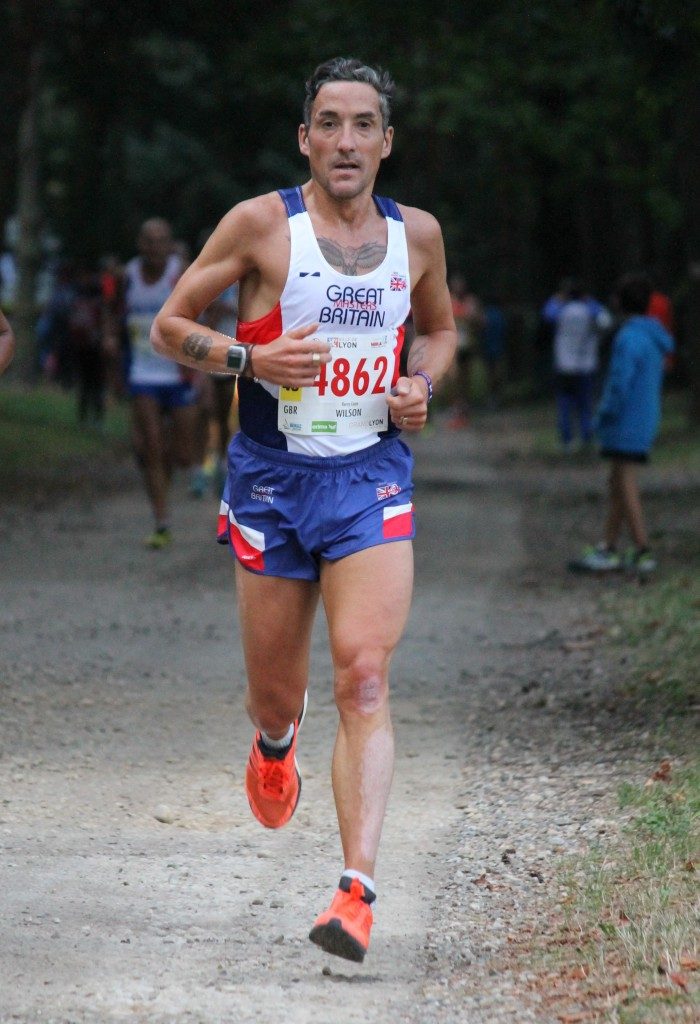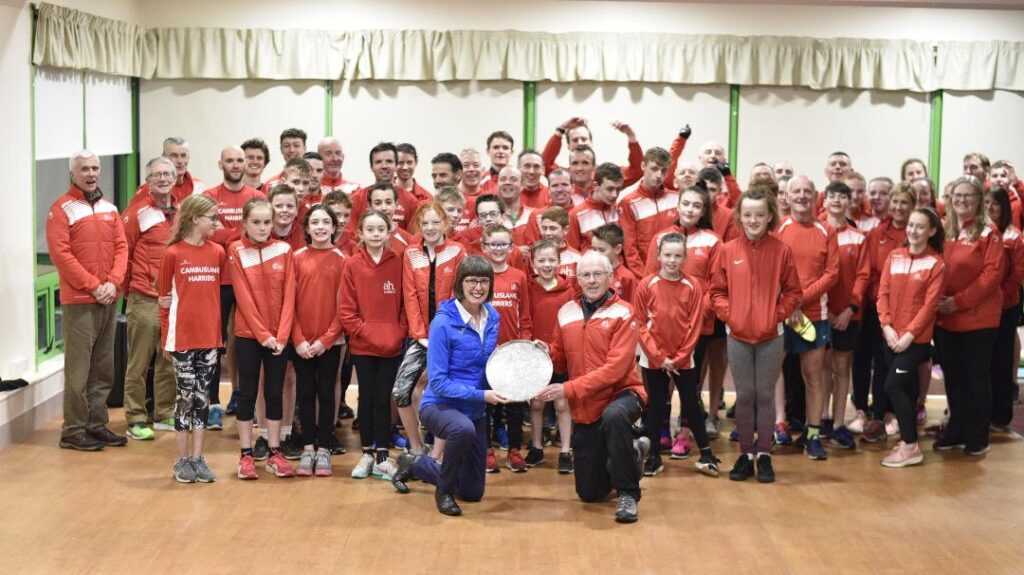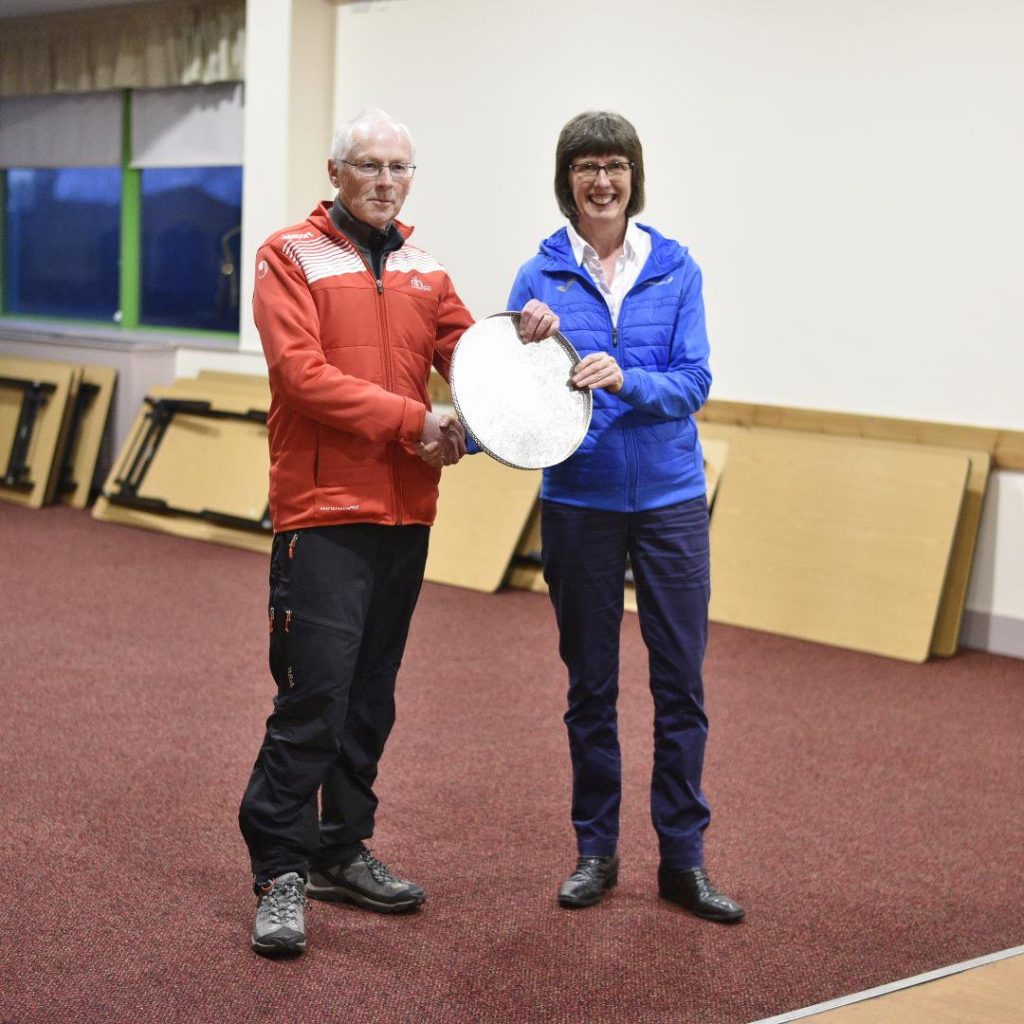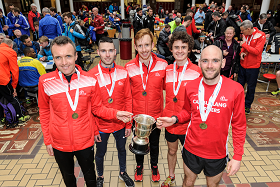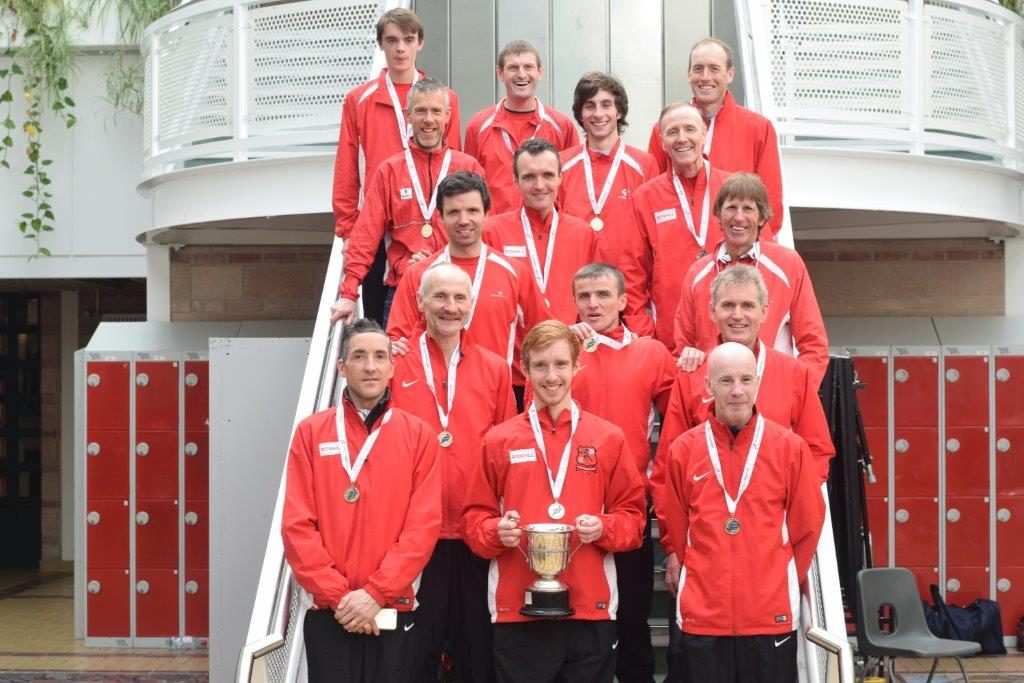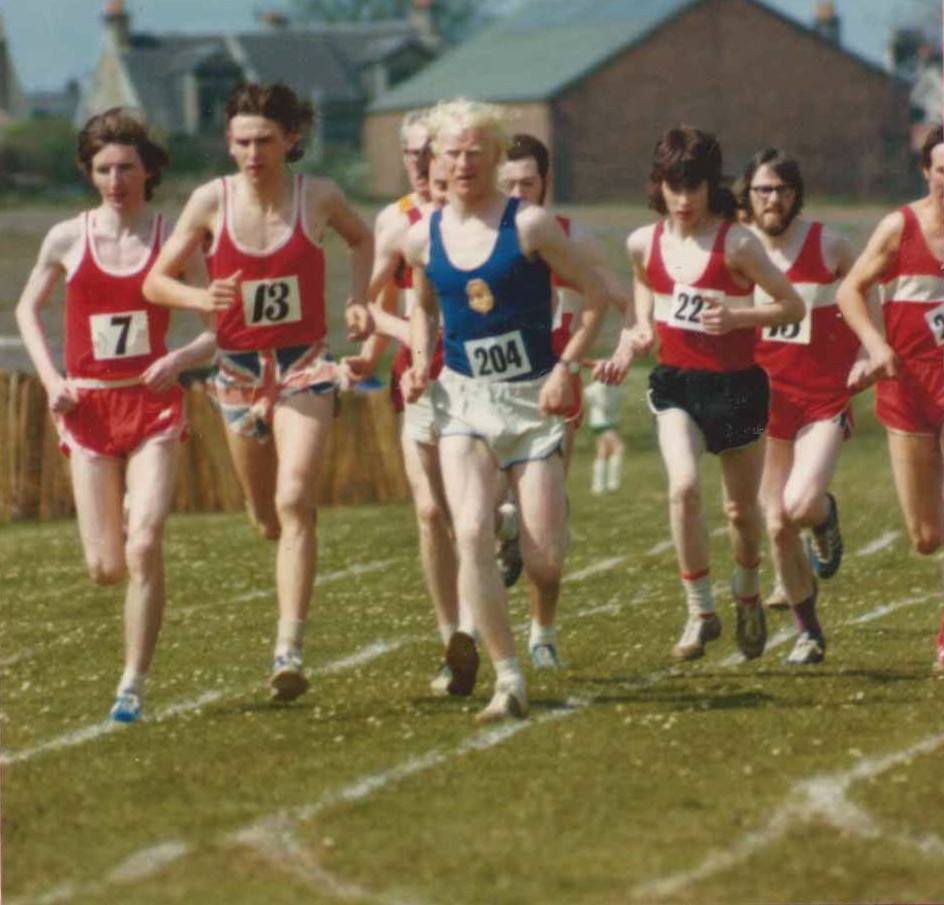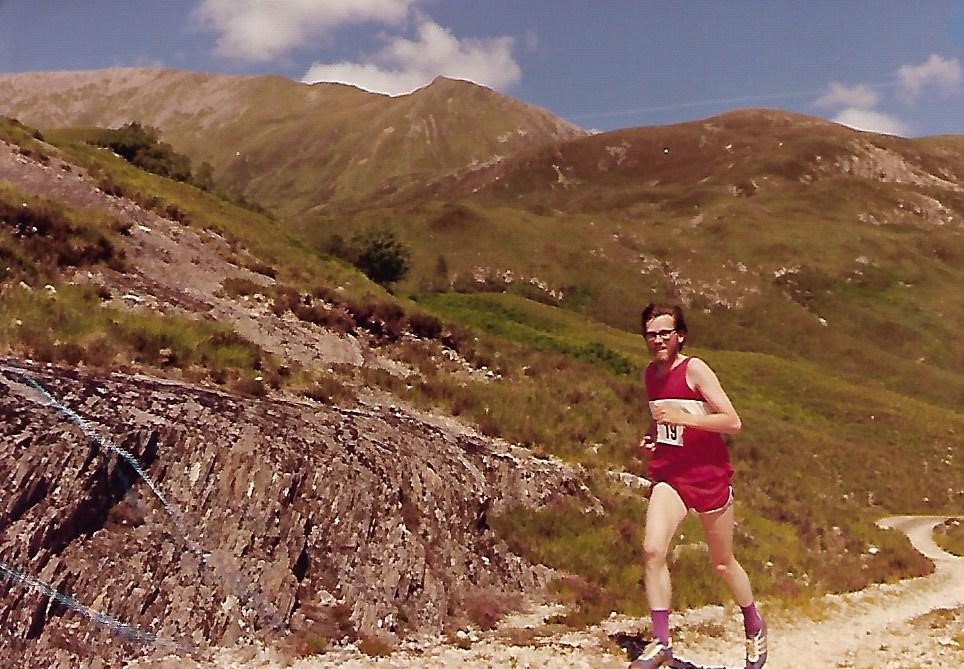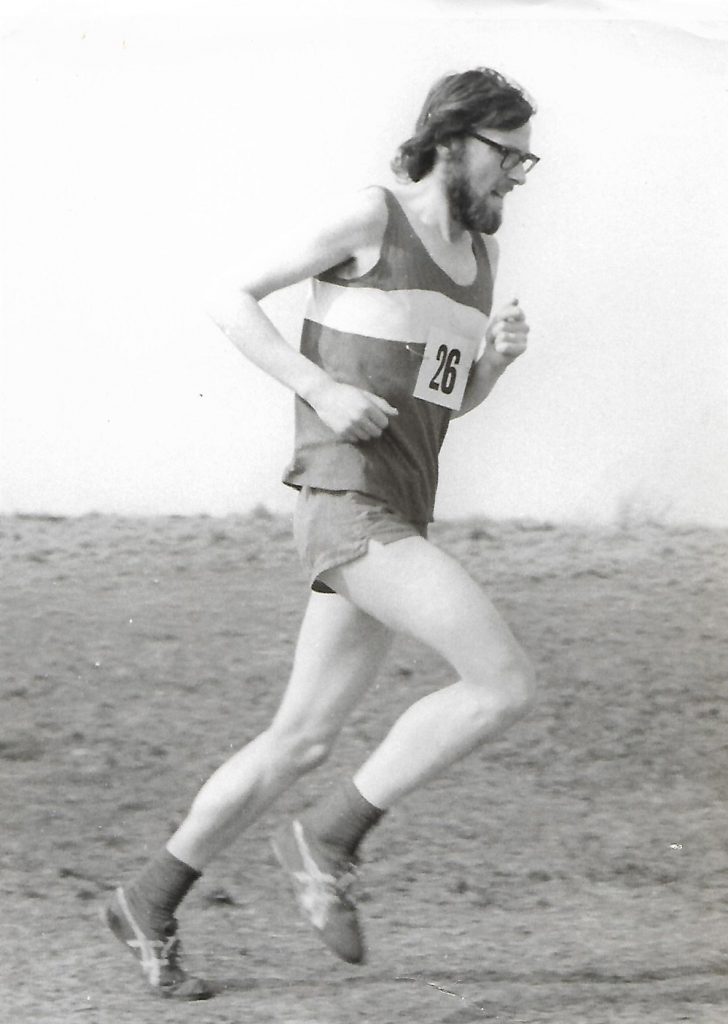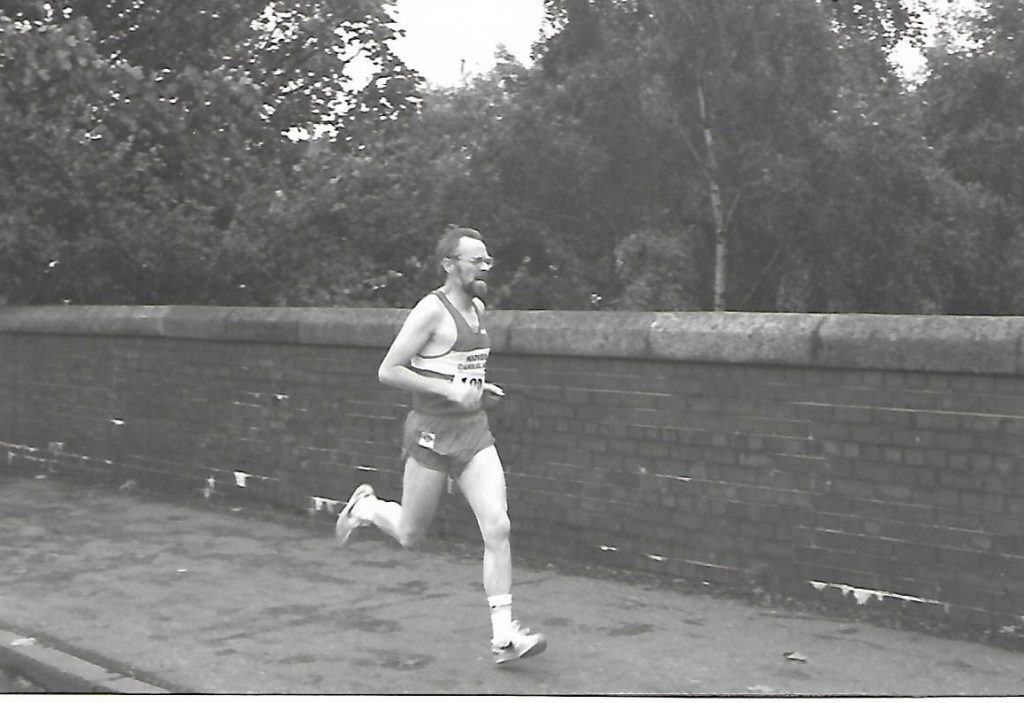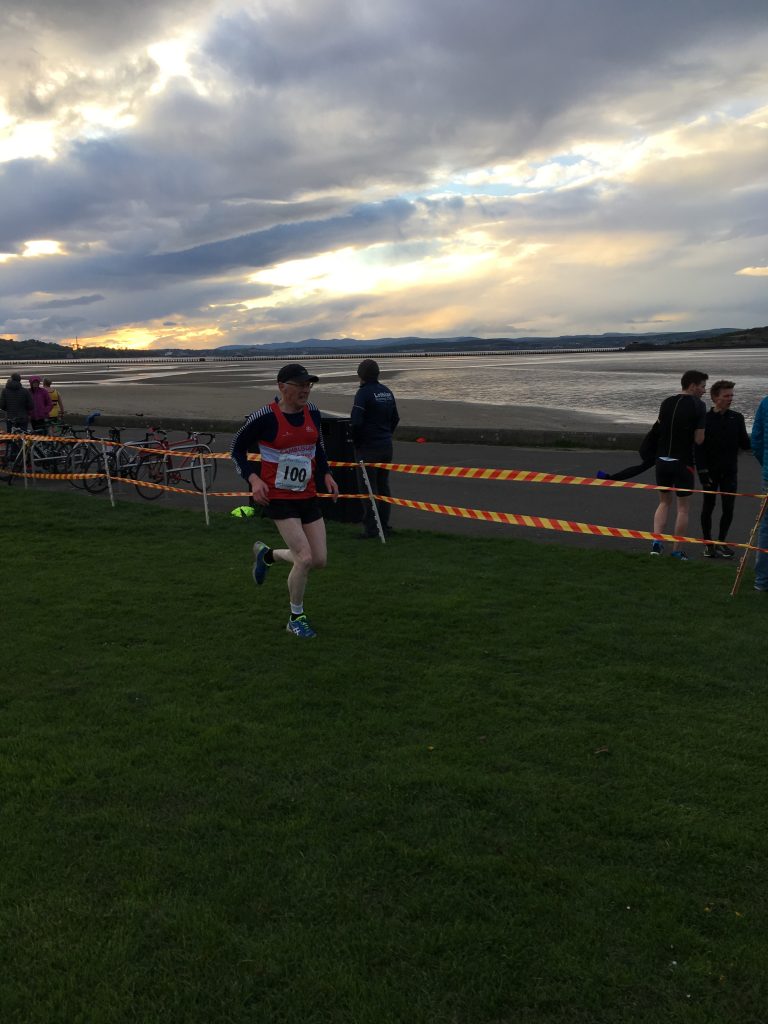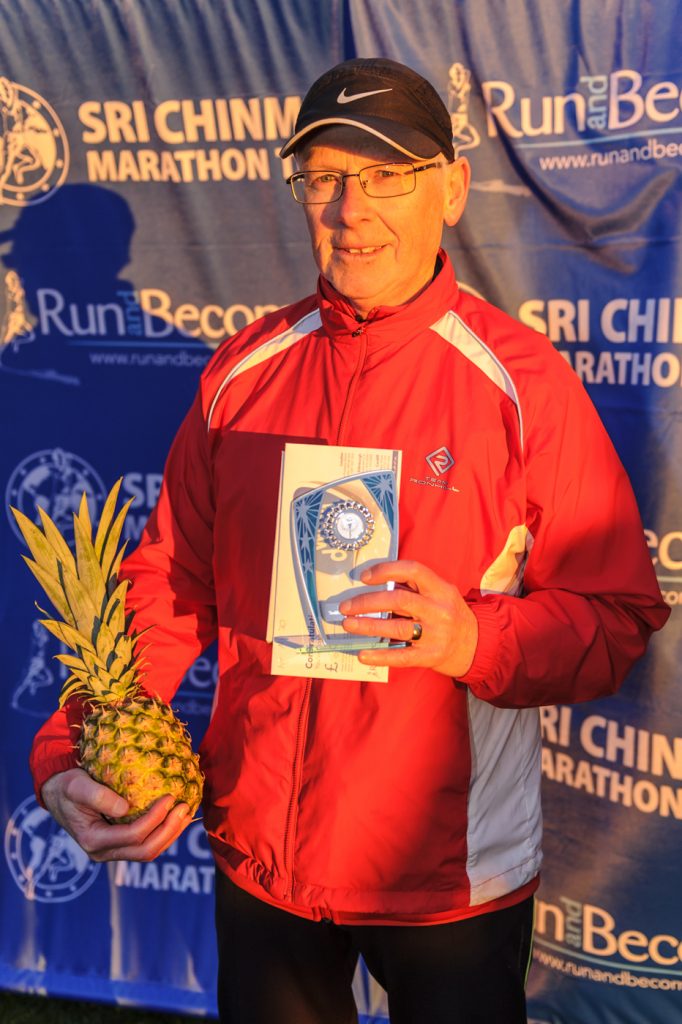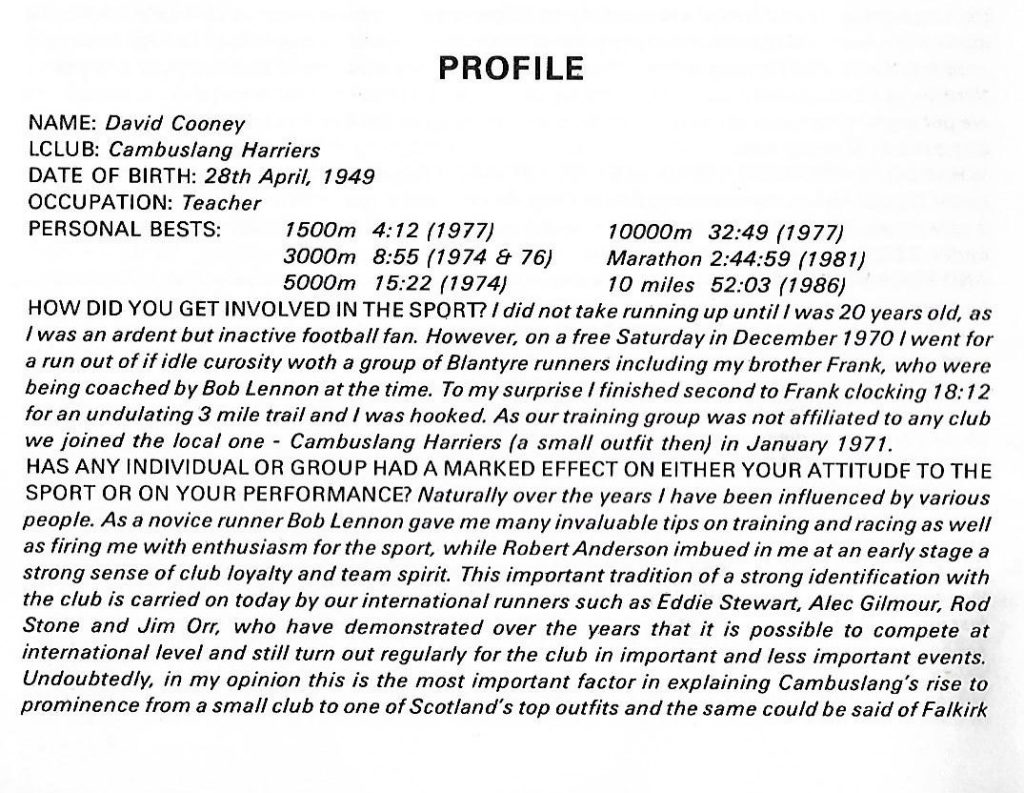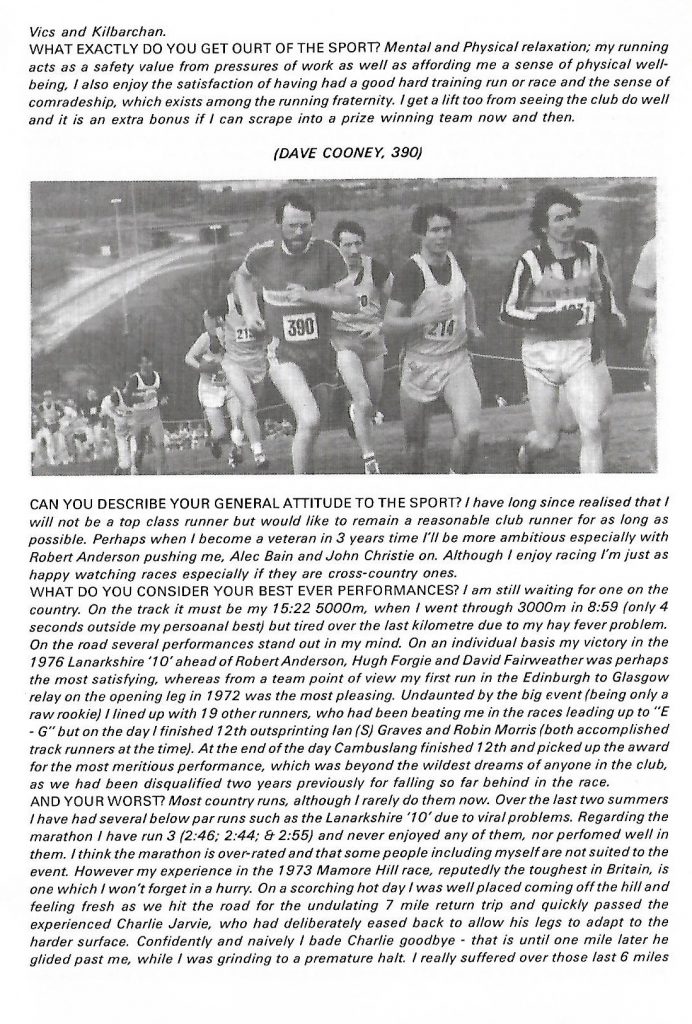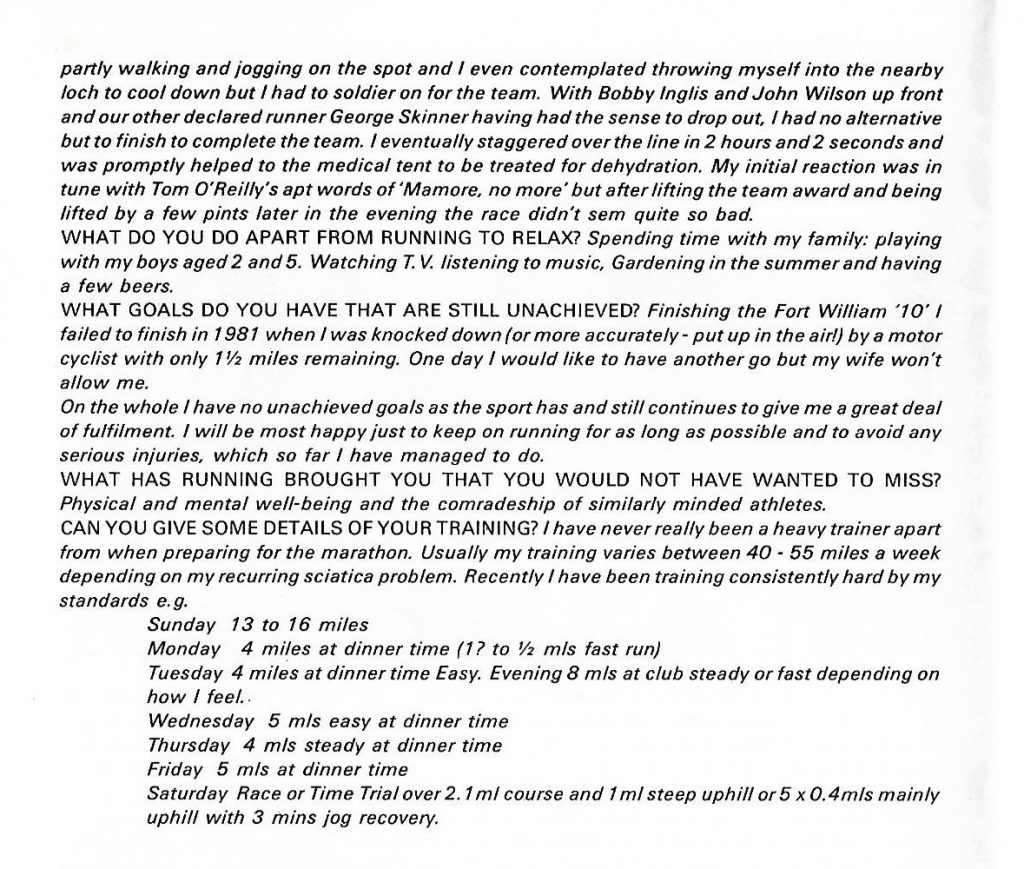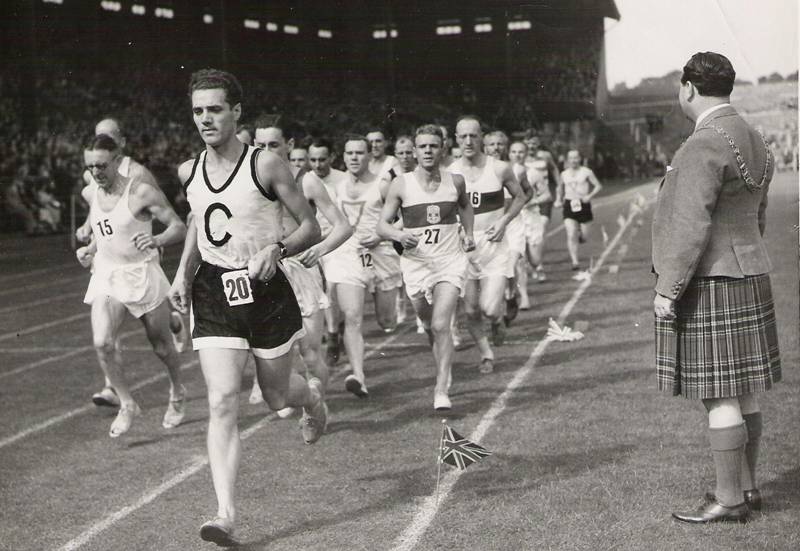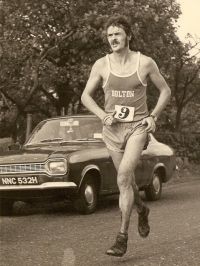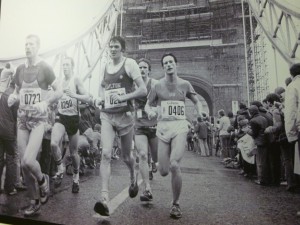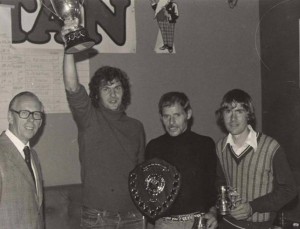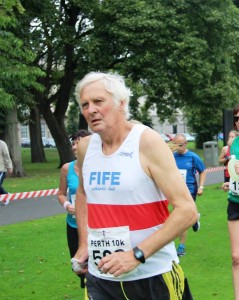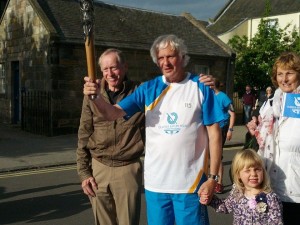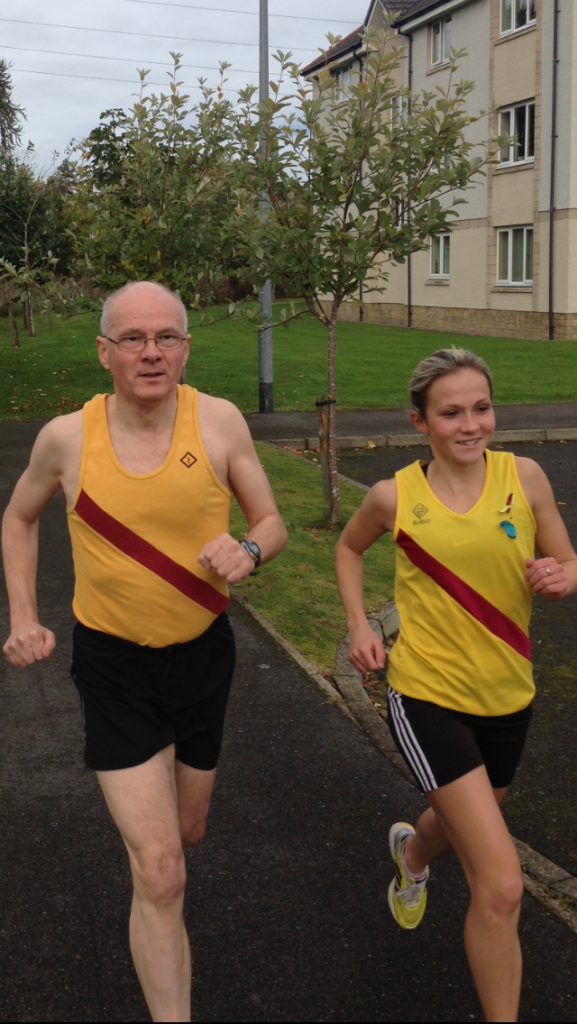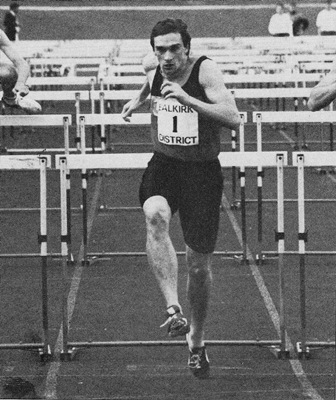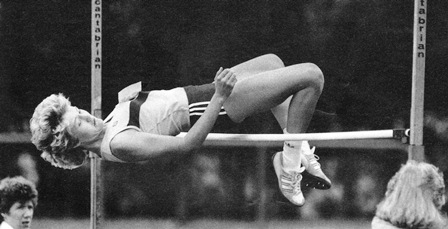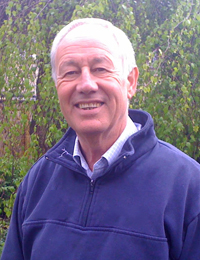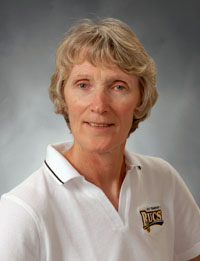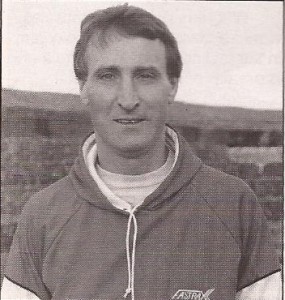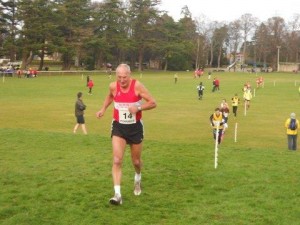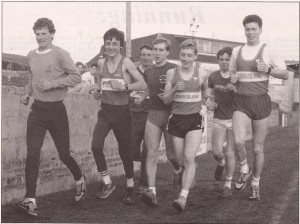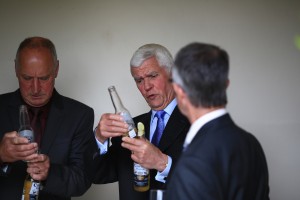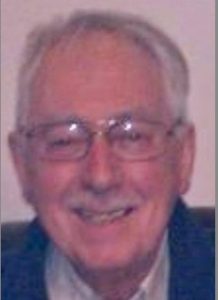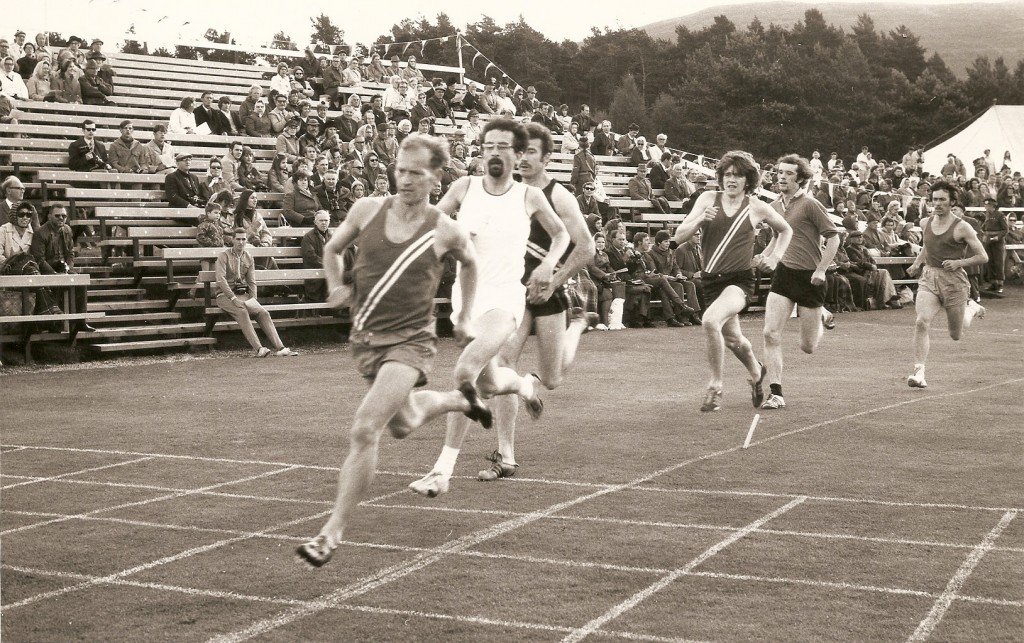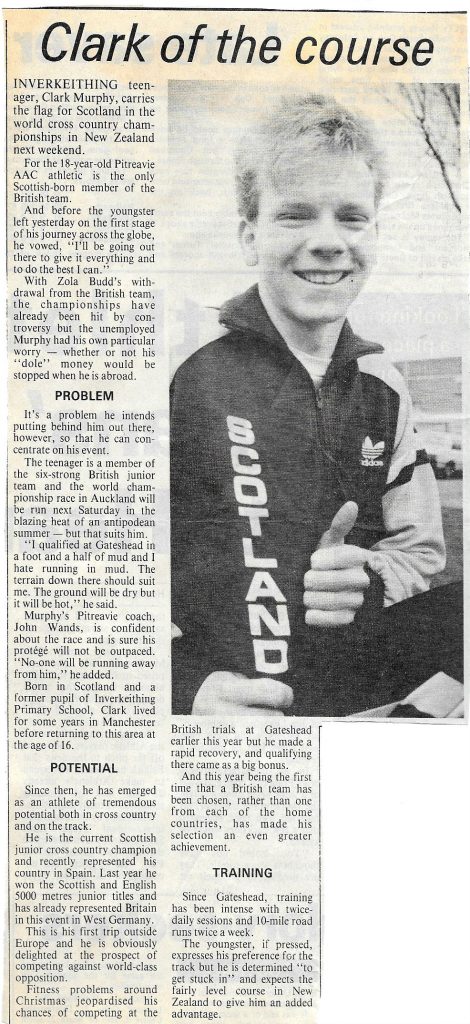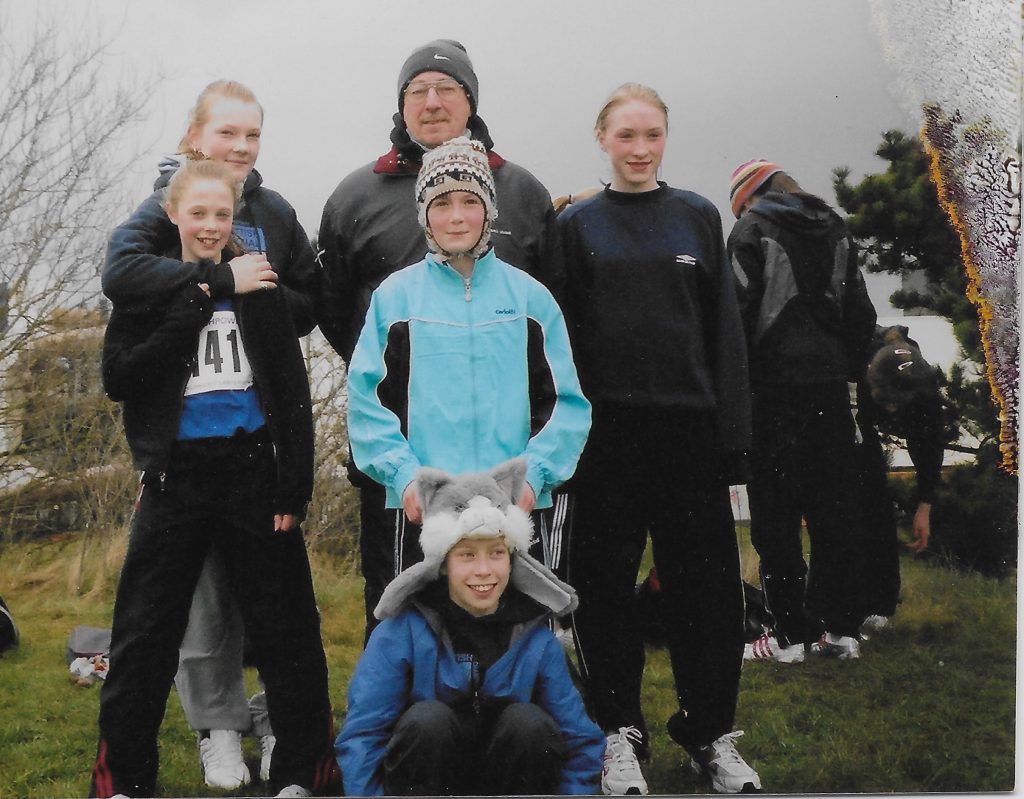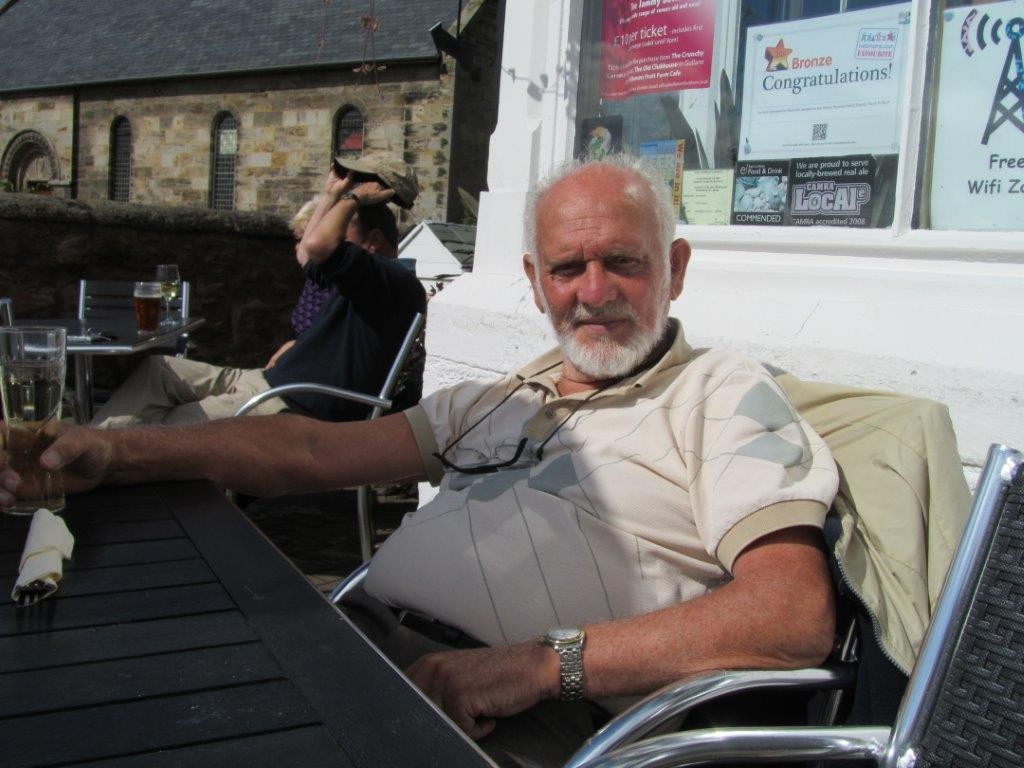
Bill outside the Old Clubhouse restaurant in Gullane in 2012.
BILL WALKER is known throughout the UK as a top class coach: a quiet and friendly man, a former athlete and committee man, he is relentless in his pursuit of success (however you define it) as a coach on behalf of his athletes. Generous with his time and with a rare sense of humour he is deservedly popular. However because of his quiet and unassuming nature, he is not as well known as he should be, despite the fact that he has had a very successful career in the sport. He has received many awards including life membership of Scottish athletics and as recently as last year he received a special award from UK Athletics for his services to the sport and was also the subject of an edition of ‘Surprise, Surprise’ where no one was more surprised than he was!
Richard Winton wrote the following in the ‘Herald’ in 2012 when Bill had won the Winning Difference Award and was about to be presented with it at the Kelvin Hall.
“Bill Walker equates coaching to painting the Forth Bridge; just as he has finished guiding one athlete to the peak of their performance, another talented youngster emerges demanding his attention and expertise.
It is the reason why, 52 years after taking his first session, the septuagenarian can still be found at Meadowbank Stadium six days a week, gently cajoling elite performers, kids and those with a disability alike to shave one more second or inch from their previous bests in pursuit of their own personal glory.
It is also the reason why he will spend tomorrow afternoon at the Kelvin Hall in Glasgow, awkwardly stepping into the spotlight at the Aviva International Match to be presented with Winning Scotland Foundation’s annual Winning Difference Award ‘in recognition of his exemplary achievements and significant and lasting contribution to Scottish sport’. Walker scoffs at the suggestion he might mark the occasion, insisting that it is more cause for concern than celebration.
“I’m worried that by getting this they maybe think I’m about to die or something, that’s the danger at my age,” he says, judiciously ignoring congratulations.
Instead, he insists, his reward comes from the success of those in his command. And how rich that reward has been. Some of Scotland’s finest have come under his tutelage over the years, most notably Alan Wells, who worked on his starts with Walker in the months leading up to his 100m gold in the Moscow Olympics.
“A coach is only good if they’ve got a good athlete and Alan was never satisfied and always looking for improvement,” recalls Walker, clearly more at ease when not talking about himself. “He always felt he couldn’t be perfect so he was self-motivated, which served him well when he went out and beat every American afterwards after people tried to talk down his achievement.”
The increasing paucity of world-class Scottish competitors in the intervening years means winning a track-and-field gold in London later this year is unimaginable. As much as it pains Walker to acknowledge as much, the fact is that athletics struggles to attract the most gifted youngsters in the face of more financially appealing disciplines, such as football, tennis and golf, amid an ever expanding sporting spectrum.
Consequently, the standard has dropped – “at one time I had two part-time 800m runners doing 1.45/46mins who would be superstars now” – despite the prevalence of sponsorship deals and development of more appealing facilities affording young Scots a better chance than ever to reach the top in their chosen event.
“It’s still feasible if they are prepared to work but I think it’s a different animal now,” Walker says. “Kids don’t have the mobility and range of movement they once had because they are always sitting down playing on computers rather than being outside. Sure, we are working on identifying those weaknesses and working on them but without those basic motor skills we are starting from a lower level and their technical capabilities are limited because of that.”
We can come back to this article later but to begin at the beginning, Bill Walker like so many very good coaches started out as a runner. Like all of his generation he was called up to do two years National Service in the Army. Starting in Bath, he was transferred to Leuchars in Fife where he managed to get his 440 yards time down to 49.1 – and on grass at that. National Service was brought to an end in 1960, so Bill’s running was in the 1950’s. The time above would have placed him twelfth on the Scottish ranking lists in 2015. In other words his time on grass would have been beaten by only eleven Scottish runners on tartan more than 50 years later! He is quoted as saying “There weren’t enough jobs for everybody so I was pushed into sport to get rid of me,” he explains. “I ended up running with them and basically getting a big skive because I was practically a full-time athlete. In fact, it was so good that I signed on for an extra two years.”
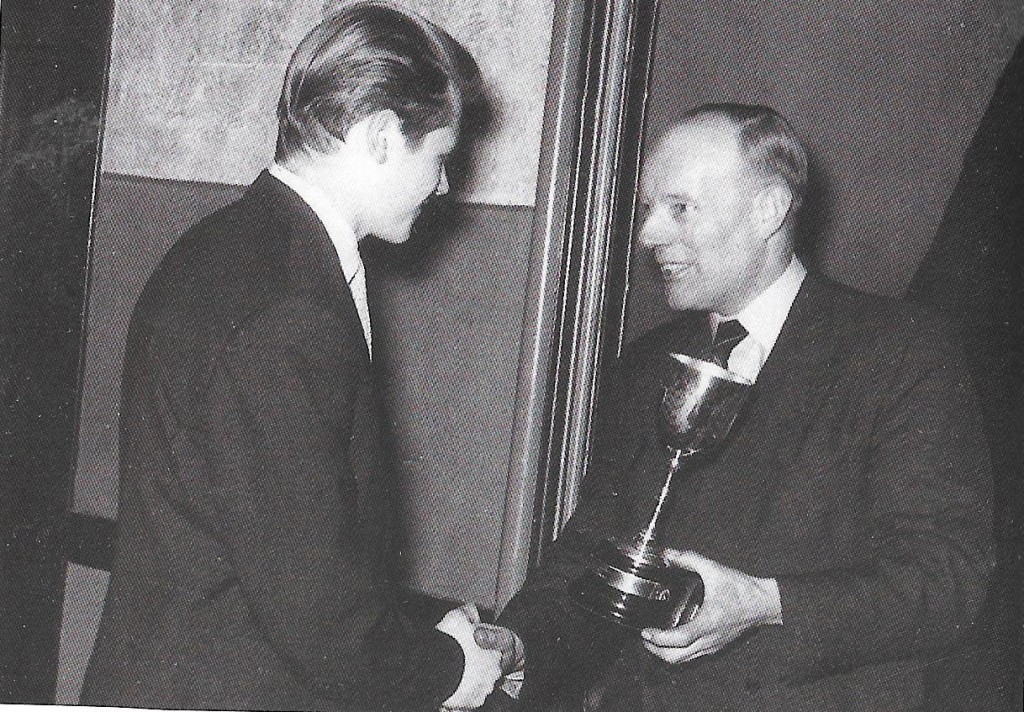
The Braidburn Junior Champion trophy being presented to Ronnie Browne
When he did finally leave the RAF, Bill worked at electrical engineering firm Ferranti before going to Heriot-Watt University as a physics lecturer. He had also joined Braidburn AC, a club with several very good runners such as Neil Donachie and Bill Linton, by then and was training with Tom Drever. It was at Ferranti that he began coaching, setting up sessions for colleagues who had spotted him training alone. That continued when he moved to Heriot-Watt. Incidentally, one of the younger members at Braidburn was a boy called Ronnie Browne (related to Peter Hoffman as it happens) who discusses his time at Braidburn in his autobiography “That Guy Fae The Corries” and ‘Big Tam Drever’ is mentioned fairly often – the book even has a picture of a young-ish Bill Walker presenting the club’s Junior Champions Trophy to Ronnie.
When Braidburn merged with several other clubs to form Edinburgh Athletic Club, Bill and Tom joined the new outfit. Bill later married Tom’s daughter Kay. Another Ferranti employee was Eric Fisher who also joined Edinburgh AC. They became friends and competed for the club as individuals but also in league matches for the team. Eric remembers travelling with Bill as part of an Edinburgh AC team trying to qualify for the British Athletics League. Bill doubled up the 400m, 400mH, steeplechase and 4 x 400 while Eric doubled up on the steeplechase and 5000m!
While working at Heriot-Watt Bill was also involved in their athletics activities setting up coaching sessions for his colleagues who joined in with his sessions. Doug Gillon, now well known as one of Scotland’s best ever and most respected sports journalists joined Edinburgh AC in 1964 and trained alongside Bill, becoming a firm friend. He remembers the time, the training and the friendships well. He recounts that
“I first met Bill when Jack Macfie and I joined EAC in the autumn of 1964. We knew nobody, but Bill (and Claude Jones and John Convery) made us very welcome. Because my girlfriend (now wife of 45 years) lived in the next close in East Claremont Street, Bill frequently gave me lifts home, to her house. He was still competing then, but was very helpful with racing and training advice, though he was never my coach in any formal sense.
John Fairgrieve (later first paid SAAA secretary), was the same vintage. At that stage I had no formal training schedule – I was absorbing the methods of Lydiard, Cerutty, and Stampfl, and picking bits out of each in a completely haphazard and ill-considered manner. I would turn up and do whatever session seemed best – no structure at all.
Club nights at Ford’s Road usually, for Jack and I, and as I recall, John Fairgrieve, would mean tackling a track rep session, usually with Bill lending advice and encouragement, and holding the watch. I do recall him joining in 200 and 400m rep sessions, but not the most savage: a 6 x 660 with a 2-min interval. At our best, the peak target was 90 seconds. Bill would be holding the watch for these. Jack, John and I would lead out two each, alternating every 200m, then free-for all on the last 200, attempting to make the time, with Bill shouting encouragement, and the seconds as we went through. The format of switching every 200m was Bill’s. It was possibly not coincidence that Jack, John and I finished in that order in the mile at the Scottish Schools the following year. In hindsight, I reckon these tough track rep sessions, drawing each other out, played a part in our modest success.
When I went to Heriot Watt University, after a year at EAC, Bill was in charge of the electron microscope. He was also in charge of the athletics and cross-country teams. He was always a great enthusiast and motivator. In winter, at lunchtimes, he oversaw weight training in the university’s mining engineering dept in the Grassmarket. Generations of athletes would have learned or been introduced to the sport, and conditioning, by him
Bill selected the teams for track and cross-country matches – always seemed involved in every aspect, up to laying courses. Not every university was as disciplined. I remember a match on a poorly-marshalled and marked course at Caird Park in Dundee. Adrian Weatherhead was about 100 yards in front of me and took a wrong turn. I put in a desperate mid-race sprint, yelling at him to come back – which he did, and still won!
For track meetings it would be much harder to put together a team. He could be compellingly persuasive: I think that’s where I first heard the philosophy of: “just go round for the point”. In hindsight I wonder how he managed to fit in the day job.
He would give lifts to highland games, explain the pleasures and pitfalls of handicap racing, and how it taught pace judgment.
*
He continued to coach his athletes and Eric Fisher tells of the first night back at the club after the successful Commonwealth Games when there were 129 children down at the track, most of them for the first time. In the midst of this, Bill was trying to do a session with Adrian (mile time in 1970: 4:00.7). At that point Eric and he had a conversation in which Eric agreed to work with the younger athletes in the club and pass the best of them on to Bill. It was a system that worked well. Bill was recognised as one of the best coaches in Scotland at the time. Frank Dick was the National Coach and the individual coaches included Eddie Taylor, Alex Naylor, George Sinclair, Gordon Cain, Sandy Ewing and Bill.
If we want to see how good Bill’s athletes became, it is instructive to look at some of them.
* Norman Gregor was SAAA 400m hurdles champion in 1974 and had 5 second places in that event as well as at 400m flat. He had personal bests of 21.8 (200m), 48.4 (400m), 16.1 (110mH), 51.56 (400mH) and 1:49.4 for 800m.
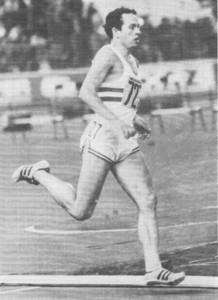
Peter Hoffman
* Peter Hoffman had been a very good sprinter who became a very good class 800m runner. His career at the top lasted from 1974 to 1982 and he competed in Olympic, European and Commonwealth Games, won gold silver and bronze at British and Scottish championships, and had pb’s of 10.8 (100m), 21.8 (200m), 34.7 (300m), 46.76 (400m), 1:46.63 (800m), 2:24.8 (1000) and 54.2 (400H). He was an outstanding athlete by any standards.
* Paul Forbes: Bill and Paul always had a close contact although John Anderson also had some input. Paul started out with EAC and was coached by Eric Fisher before training with Bill. Paul had pb’s of 47.69 for 400m, 1:45.66 for 800m and competed in three Commonwealth Games, and won gold at both UK and Scottish championships. In 1983 Paul ran 1:46.83 which would have been a Scottish Native Record but he was denied the honour because he was not wearing a club vest;
* Peter Little was a top class young sprinter who competed between 1976 and 1981. He had best times of 6.84 (60mi)10.6 (100m), 21.5 (200m), 48.49 (400m) and won gold, silver and bronze both north and south of the border, winning GB championships indoors at a time when there was no Scottish indoor scene at all.
* Roger Jenkins won the SAAA 400m twice, one second, and was third in the AAA’s 400M. Competed in the European and Commonwealth Games and had pb’s of 10.5 (100m), 21.3 (200m), 46.49 (400m) and 51.66 (400mH).
* Ross Hepburn was a high jumper who was originally coached by Tom Drever. I quote directly from the SATS website: Talented young athlete who set world age bests at the age of 13 (1.88m) and 14 (2.04m). He represented Scotland at the age of 14 years 334 days v England and Wales, then represented GB v Russia aged 15 years 316 days. This made him the youngest male athlete ever to compete for Great Britain. AAA Youths champion but retired from the sport through injury while still in his teens.
He has also worked with others such as Graeme Grant, Ann Dunnigan and Mary Speedman .
The Edinburgh AC club record for 4 x 400m relay is a magnificent 3:08.9 and was set by a team of Peter Hoffman, Paul Forbes, Norman Gregor and Roger Jenkins: all coached by the same coach – Bill Walker.
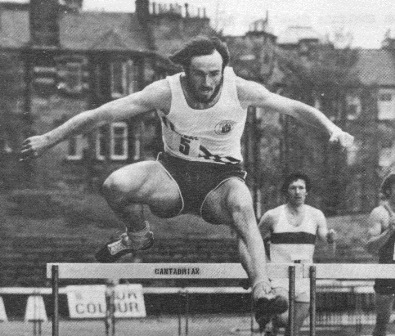
Norman Gregor
Several of the wonderful athletes mentioned above were in action at the same or similar distances at the same time and yet another top class athlete – Adrian Weatherhead – spoke of some of them and Bill’s sessions.
“I first met Bill when I was an undergraduate at Heriot Watt University. I was just starting my athletics career and Bill was very keen to organise a Heriot Watt athletics team using his expertise from his days in the RAF where he had been a 400 metre runner. When he left the university to take up a post of Assistant Manager at Meadowbank he rapidly accumulated a very successful squad of athletes with whom I trained a number of times each week.
Many of the sessions had an all GB international line up ( Pete Hoffman, Paul Forbes, Norman Gregor, Roger Jenkins and myself) and were of the most murderously high quality where each individual had some dominant quality which he could impose on the others.
Bill has continued his excellent coaching and has inspired young athletes over the decades. I am proud to relate that he has many times over the years given some shock therapy to some of his protégés by informing them of the quality of the sessions attained by the GB training squad of the 1970s!!”
*
Bill was also very active in the club away from the track and as well as organising club coaching, he served on the the Committee and progressed through the system until in 1969 he was elected on to SAAA East District and General Committees as the Heriot Watt representative. By 1977 Bill was the fourth longest serving member of the SAAA General Committee, with only Oliver Dickson, John McClurg and Eddie Taylor having been longer than he had on the 43 strong body. He had progressed to being on the Joint Coaching Committee and had qualified as a Senior Coach for Sprints. As an official he was a Grade 1 for track. jumps and throws, a marksman and Grade 3 Timekeeper. He had come a long way in a relatively short time.
The Commonwealth Games of 1970 had been a great success and sports promoters started to bring the best athletes in the world to Scotland. There were three tracks of a high enough standard for these meetings, Grangemouth, Coatbridge and Meadowbank, which was not just a track but a stadium with memories of the great athletes and performances at the Games. Athletes like John Walker, Irene Szewinska, Steve Scott and many others from Europe, the Antipodes and America were mixing it with the best of British and Frank Clement, Geoff Capes, Allan Wells and David Jenkins. On 19th August 1978 the Glenlivet Highland Games took place at Meadowbank and many of the Scottish athletics top brass were involved as was Bill, by then assistant manager at Meadowbank, in the organisation of the meeting. On the following day the Coca Cola Meeting took place at Coatbridge – this was not the first time that the two meetings had followed one on the other and athletics fans loved it. Almost all the same athletes turned out: Capes, Wells, Clement, Black, etc were all there. Everybody knew that these athletes were being paid, at the very least generous ‘expenses’ were on offer. The European circus was just starting up and payment of athletes was an open secret. Unfortunately details of some athletes expenses from Meadowbank became public and the SAAA Committee started to ferret out the truth of the situation. Attention finally focused on Bill Walker and his team. The investigation did not take place until after a police inquiry had been held. The police found no reason to proceed any further. As has been said, Bill was on general committee of the SAAA and a special meeting was called. The upshot of that meeting was that he was suspended.
This provoked an uproar in the athletics community. Andy Arbuckle of Fife AC acquired the signatures of the requisite number of clubs to call a Special General Meeting of all clubs with the intention of having the suspension lifted immediately. The result was the lifting of the suspension. There is no doubt that Bill’s reputation and the high regard in which he was held made a great contribution to the final decision. The whole affair was a blot on the record of the SAAA. An interesting side light on the affair was that an attempt was made to investigate the expenses paid at the Coatbridge meeting. However at the meeting at which the decision was taken to lift the suspension the following appeared in the minutes: “On 24th May 1979, a letter was received from Monklands District Council, stating that the information requested would only be made available on condition that an inquiry would be held into all International Sports Meetings held in the UK, Europe and America in 1978.” There followed a correspondence with the Council but no action was taken with regard to Coatbridge.
It should be pointed out though that there was general support for Bill from the Scottish athletics community, and two British international stars spoke out on his behalf – David Jenkins and Geoff Capes – at a time when it could have ruined their careers as sportsmen. In addition, the spotlight shone on the proceedings by journalists such as Doug Gillon made sure that nothing that happened was exempt from scrutiny. It was nonetheless a very difficult time for Bill and his family.
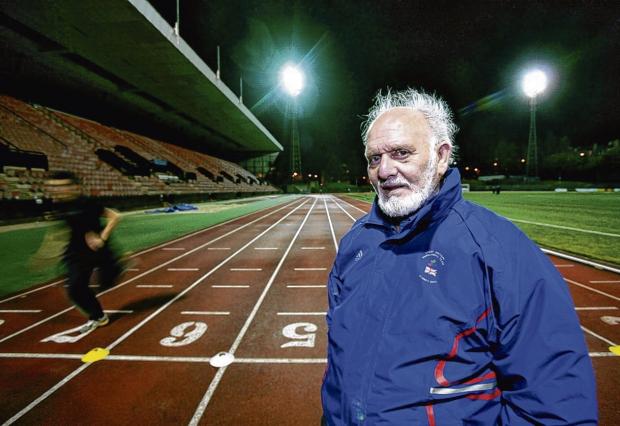
The surprising thing is that Bill went on coaching through it all. He kept producing top class athletes despite the toll that the whole affair must have had on his family life as well as on him personally. A look at the names above indicates that he was working with Adrian Weatherhead, Peter Hoffman, Peter Little and others – none of them suffered at all.
What was he like as a coach? What did he expect of the athletes? One thing they must do, he said in an interview, is demonstrate an appetite for work. He continued, “It keeps me young and, as long as the athletes are giving me everything, I’m happy,” explains Walker, whose science background led him to dabble in photo finish and electric timing technology years before it became popular. “If they are committing themselves, they deserve the same commitment back but I won’t tolerate skiving. If they are wasting my time I will tell them, no matter what level they are at. With that attitude, I think they’ll have to carry me off the track in a coffin in the end but that would maybe be quite a nice way to go.”
Bill has a reputation of being a very strict coach who thinks that athletic clubs should not spend their time with those who come along not prepared to do the work. His sessions all start on time and there is the tale of an occasion when there was no athlete ready to go at the appointed starting time. Bill called “Go!”, started his watch and after the non-rep rep went to the cafeteria. A late arrival turned up in the cafeteria only to be told, it was over! At another time, an international sprinter was to practice sprint starts: she had three faulty starts and Bill told her to go home. When she protested he told her that’s what would happen in a competition, so – go home, we’re finished for tonight! The same man stands up for his athletes – who always come first – at times to extremes. As at the time when he encouraged his women runners to move from Edinburgh AC to their city rivals Edinburgh Southern Harriers because the demands being made of the athletes in team competition were against their better interests.
Many coaches and athletes remain friends long after the athlete’s career in the sport is over and Doug Gillon says “In my career as an athletics journalist, I have lost count of the number of athletes who have sung Bill’s praises, who talk of his selfless help, generosity, and integrity. His good humour and enthusiasm is unfailing, and remarkable after so long spent as a coach.”
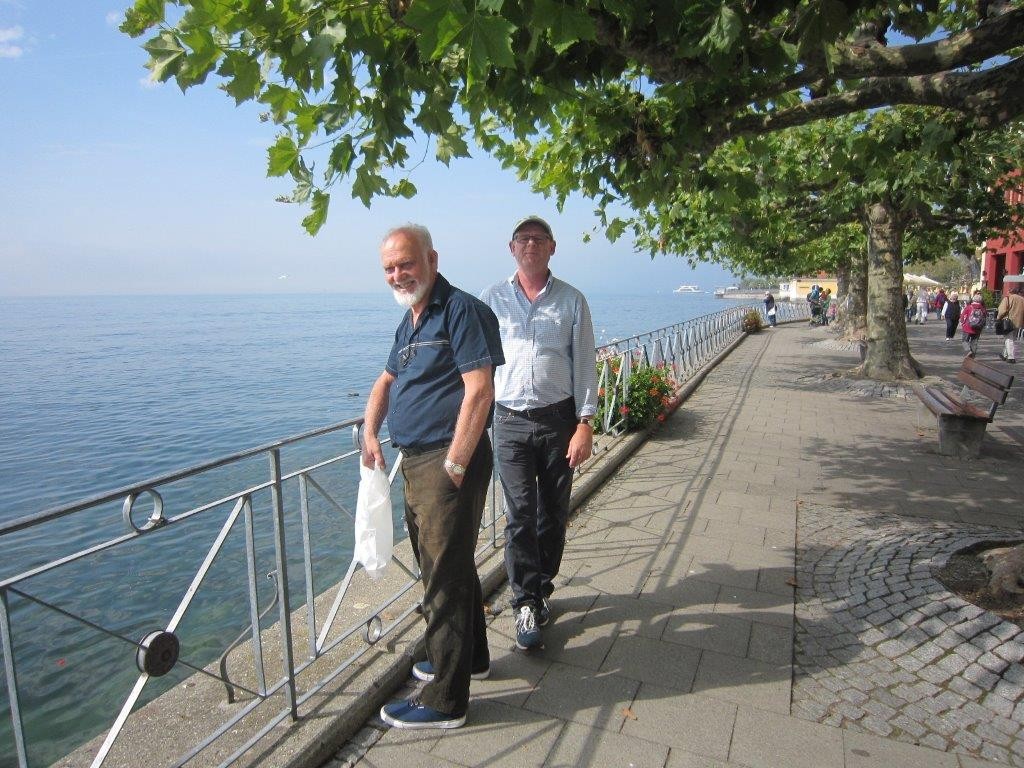
Bill on holiday at Lake Konstanz with Ross Hepburn
Ross Hepburn , for whom Bill was a friend and advisor, remains a good friend to this day, decades after Ross’s retirement from high jumping. He says:
“I was at Fords Road when Mr Jones (Claude) and Mr.Carrigan (Jimmy) suggested when l was 12 years old that l go to Meadowbank to improve my talents as l was more a jumper/sprinter, with needs regarding training other than what was possible at Saughton. There, l was to meet a Mr. Walker.
Bill introduced me to his father in law, Tom (Drever), who started me off on my road as a high jumper. I remember Tom and Bill taking me in 1974 into the Meadowbank weights room to test me at sit-ups, pull-ups etc. I can still see them both giving me a nod of approval. Later Bill would allow me to join in one or two winter sessions with his athletes – sessions like 20 x 200 with a walk back recovery – l never saw the end of a session, and Bill would just smile at me saying l told you that you still have a long way to go – and l decided l’m not going that far – l think he knew that anyway.
I left for Germany at a young age (17) but when l came home every other year for a visit l instinctively headed for Meadowbank. Bill would be pleased to see me and always found time for a cup of tea in the cafeteria, and he would insist on paying for it, and to enquire how l was doing. Or we would go for lunch together and he would inform me of what was going on … this has gone on now for the best part of 36 years!
During these years l did run into one or two of life’s tests and troubles, Bill was someone l could rely on for good advice. Last year I visited Bill at his home in Edinburgh, and was physically moved to see a large photograph of Tom hanging in his hallway, a great man! And I recall a nice demonstration of Bill’s commitment to the sport. I remember hearing a story of Bill driving past Meadowbank with his family in the car, and one of the kids in the back said: “Look mummy, that’s where Daddy lives” …… you can’t describe dedication much better than that!
Three years ago Bill came over to Germany and stayed with me for a week. This was great for catching up on old times, and l was astonished at how fit he was for his age when we walked up a hill one day. If l ever reach his age then (late seventies) then l’ll try that hill, and probably see Bill saying “You still have a long way to go!”
I hope there are many more years ahead for our yearly or twice-yearly lunches together!”
*
When addressing new coaches, Jimmy Campbell, another master coach, used to take the chalk, hold it sideways to maximise the size of the letters, and write on the board the single word DIVORCE, before saying that that was where they might be heading if they did the job properly. Bill never had that problem. His family were all involved in the sport and that support must have been invaluable to him throughout his career. His son Clint has followed Bill into the area of electronic timing. Ross looks at this and says
In 1976 Tom moved to Limassol, Cyprus, after he lost his wife. Once settled in he invited his grandson Clint (Bill’s son) and I to visit him for Christmas / New Year ’76/’77. It was a great trip for two young lads. Bill later used this Cyprus connection for a few years, taking athletes to warm weather training. Bill also organised the Christmas party and dance for EAC for a while. One story Bill enjoys telling was when he had 16-year-old Clint helping at Meadowbank during an international match. Clint’s job was to guard the outside door from the track which led to the concourse and stairs up to the cafeteria and office area. You could not get through unless you had a pass. Well along comes TV commentator Archie McPherson. Clint, being a bit like his dad – very straight and correct – asks him for his pass. Archie didn’t posses one, and was kindly told by Clint he can’t get in. No comment as to what Archie said.
Clint later followed his dad into the field of electronic timing. I remember Bill always was technically strong, and tried to set up the best possibilities for athletes regarding timing. Bill mentioned to me how Clint was fascinated by this. He later went on to programme the most complicated systems and worked at many major Games for a Swiss timing company. Sadly, last time I visited Bill he had had a lot of his equipment stolen. Thieves had put a small child through his small living room window and got the gear out that way. Being Bill, he periodically checked the local pawn shops and was able to get some of the stuff back!”
Staying on the topic of timing where Bill’s expertise is generally acknowledged, Doug says that he remembers Bill and Clint working on the photofinish/timing at stadia all over Britain. “They invariably seemed last of the technical guys and officials to leave. And in a media context he was always singularly helpful, in contrast to the majority of the blazer brigade. He always struck me as an “athletes’ man” rather than an “officials’ man”, in much the same way as I always regarded Raymond Hutcheson and Bob Stephen, and many of our other coaches . . . the kind of folk who never forgot what it was to be an athlete, and what was important to them.”
I do remember Bill giving me one smashing story from the wee room in the Gods, at Meadowbank. It was July 18, in the summer of 1998, and Ian Mackie and Dougie Walker had a tremendous tussle in the 100m final at the Scottish. The wind was +2.9. Mackie timed at 10.00 and Walker at 10.01. Bill told me that Mackie had actually run 9.994sec, thus being one of only seven Caucasians at that time to have broken 10.00. Ironically the women’s 100 final (Rostek beat McGillivray) was wind-legal.”
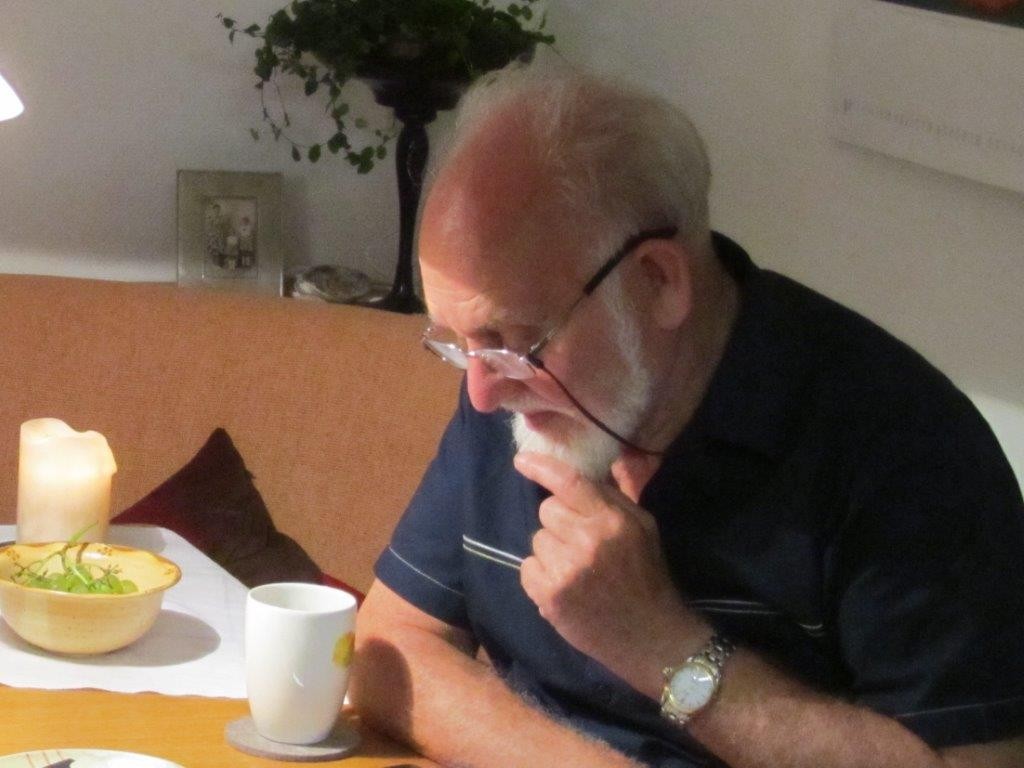
An aspect of Bill’s activities that hasn’t been touched on so far is his commitment to community sport. There are several articles online in which this is mentioned but some the passion can be felt from the article in the ‘Scotsman’ of 16th June 2010 which can be found at http://www.scotsman.com/news/bill-walker-without-help-we-will-be-fit-for-nothing-1-1244565 .
He also discusses fitness levels in the community at large in the article by Richard Winton quoted from above and which can be accessed at
http://www.heraldscotland.com/sport/13045776.Local_Hero__the_Walker_who_just_keeps_on_running/
Bill has taken part in many activities fostering sport in the community and has received several awards for this. He almost always passes on any money raised to athletics causes, either to the club or to another related cause. See this article from Deadline News of 12th March 2012which as about efforts to assist a young sprinter come back from Gambia to Scotland.
http://www.deadlinenews.co.uk/2012/03/12/scots-coach-raising-funds-to-fly-gambian-sprinter-back-for-commonwealth-games/
This interest in Community Sport was the key to getting him to the television studio in Edinburgh in August last year when he was the subject of a “Surprise, surprise!” sting. Old friend and club mate Eric Fisher lured him to the studio on the pretext that they were to take part in a discussion about sport in the community where he was duly surprised!
http://www.edinburghnews.scotsman.com/news/city-olympic-hero-s-coach-on-surprise-surprise-1-3600837
Finally, we have tributes to Bill and his work from three coaches who know him well – Hamish Telfer, Eric Simpson and Frank Dick on a separate page which can be seen by clicking here
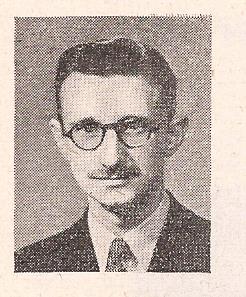 Jim’s ‘Scots Athlete’ photograph
Jim’s ‘Scots Athlete’ photograph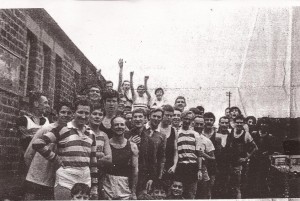 The picture above was taken at an inter-club run at Milngavie in November 1969 In the picture you might spot
The picture above was taken at an inter-club run at Milngavie in November 1969 In the picture you might spot